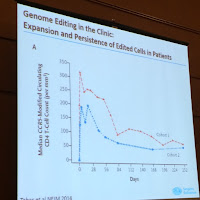New antiviral medications and combination therapies tend to emerge every few years, with over 30 currently on the market. I don't even want to venture a guess as to how much money big pharma has made as a result, nor do I care to outline all of the potential side effects. Although grateful for the extended lifespan of those afflicted with HIV, I have often wondered... what if we could modify our immune system to be resistant to HIV?
Guess what... we can. This technique has worked in six patients so far in phase II clinical trials. The technique involves harvesting a patient's T-cells, using genome-editing techniques to disrupt the gene that controls the receptor used by HIV to infect those cells, and returning the modified cells to the patient. By editing a major co-receptor of HIV, CCR5, in CD4 T cells, rendering the CCR5 permanently dysfunctional by a zinc-finger nuclease.
The team is using the same genome-editing technique to modify hematopoietic stem cells ex vivo, with the goal of treating hemoglobinopathies such as sickle-cell anemia and transfusion-dependent beta-thalassemia.
 |
| Disease Targets for Genome Editing in Hematology |

No comments:
Post a Comment